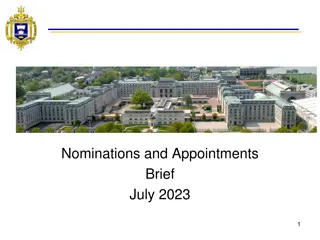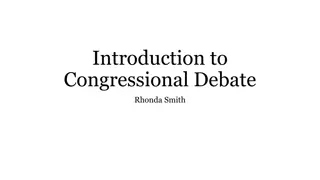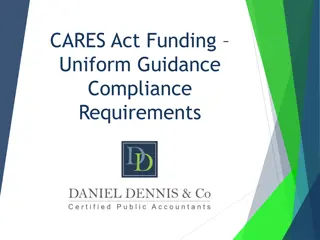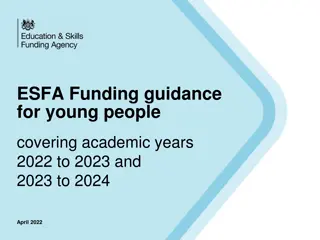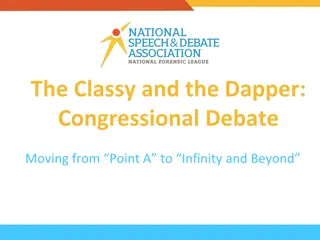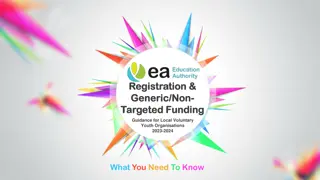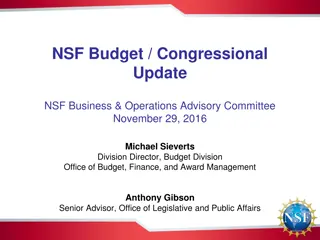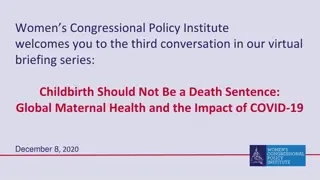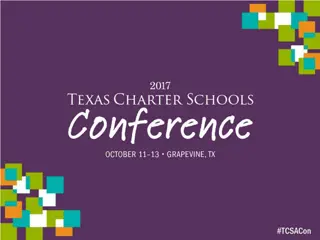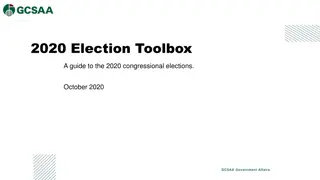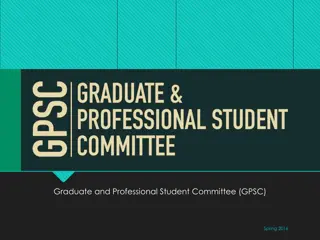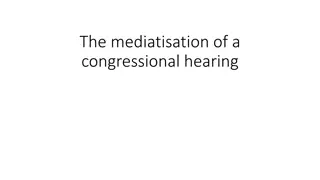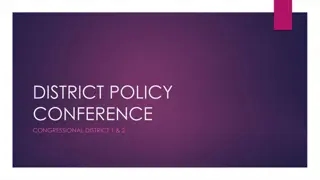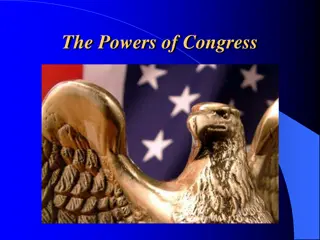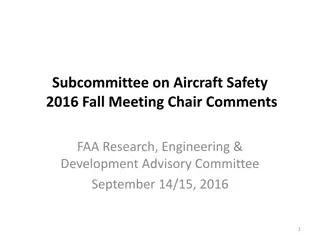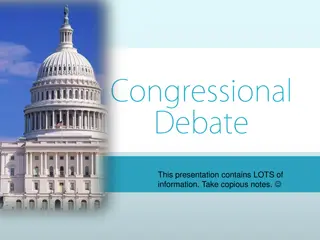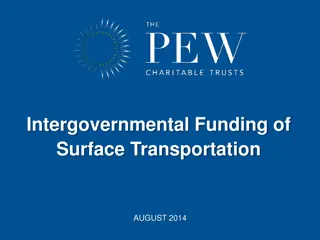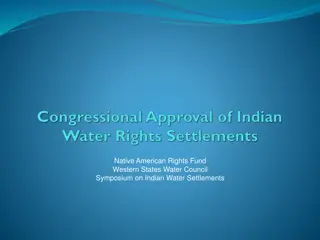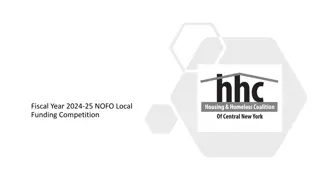Understanding Earmarks and Congressional Funding Guidance
Explore the world of Congressional earmarks, including their history, recent changes, and guidance for pursuing Congressionally Directed Spending (CDS) or Community Project Funding (CPF) in Fiscal Year 2024. Learn about eligibility criteria, project limitations, and deadlines for submission, emphasizing the opportunities and benefits of engaging with Congress for funding and relationship-building.
Download Presentation

Please find below an Image/Link to download the presentation.
The content on the website is provided AS IS for your information and personal use only. It may not be sold, licensed, or shared on other websites without obtaining consent from the author. Download presentation by click this link. If you encounter any issues during the download, it is possible that the publisher has removed the file from their server.
E N D
Presentation Transcript
Engaging with Congress in Fiscal Year 2024 Pursuing Congressionally Directed Spending and Community Project Funding Bill Harper, Partner HarperDowning LLC Bill@HarperDowning.com Specializing in federal policy and Congressional appropriations for businesses and non-profits
CONGRESSIONAL EARMARKS ARE: Senate = Congressionally Directed Spending (CDS) House = Community Project Funding (CPF)
The House Appropriations Committee uses the definition of earmark found in House rule XXI. A Congressional earmark is defined as a provision or report language included primarily at the request of a Member, Delegate, Resident Commissioner, or Senator providing, authorizing or recommending a specific amount of discretionary budget authority, credit authority, or other spending authority for a contract, loan, loan guarantee, grant, loan authority, or other expenditure with or to an entity, or targeted to a specific State, locality or Congressional district, other than through a statutory or administrative formula driven or competitive award process.
RECENT EARMARK HISTORY In 2011: Congressional earmarks banned. In 2021: Congress reinstated earmarks non-profit organizations units of local, state, tribal governments For-profit entities remain banned. In December 2022, the Fiscal Year 2023 Consolidated Appropriations Act became law and included more than 7,200 earmarks totaling $15 billion.
Two Reasons to Explore Pursuing Congressionally Directed Spending or Community Project Funding 1) Opportunity (not guarantee) to capture federal funding for your organization for a capital project or program. 2) Building and sustaining a relationship with your Senators and/or Representative and their staffs both in state and in Washington, D.C. that will allow for on-going engagement on funding, policy, or support for grant funding.
Guidance for CDS/CPFs FY2024 Only non-profit organizations and local, state, Tribal governments are eligible. For-profit companies remain banned. Memorials, museums, or commemoratives are explicitly prohibited by the House Appropriations Committee, but not the Senate. Maximum 15 projects per House members can be submitted to the Appropriations Committee. The Senate has no limit on the number of projects that can be submitted to the Appropriations Committee. DEADLINES for project submission are set by individual offices. Check your Senator or Representative s DEADLINES!
How to start? Who are your Senators and Member of Congress? Go to Senator/Member official websites look for FY2024 appropriations EXAMPLE: https://www.gillibrand.senate.gov/appropriation/fy24-appropriations-requests EXAMPLE: https://cole.house.gov/contact/fy-2024-request-forms Understand the Senator/Member CDS/CFP process, criteria, and deadlines. How much money should the project ask for? Range can be from $250,000 to $4 million. Remember this is ONE time money. Matching funds and plans for sustainment are important. Who is the staff point of contact in the state/district and/or in DC for appropriations project? Make contact and introduce yourself and your organization. Discuss the proposed project and ask questions. Ask for help. Ask your Senator/Member or their staff to visit your organization for tour and discussion
FY 2024 Eligible Funding Accounts Relevant to Arts Organizations THIS DEFINES YOUR PROJECT Agriculture Subcommittee USDA Rural Development: Community Facilities grants (House and Senate) Interior, Environment Subcommittee National Park Service Historic Preservation Fund (Senate only) Labor, Health, Human Services, Education Subcommittee (Senate only) Dept. of Education Innovation and Improvement/Fund for the Improvement of Education Dept. of Education Higher Education/Fund for the Improvement of Postsecondary Education Transportation, Housing Urban Dev. Subcommittee HUD Community Development Fund/Economic Development Initiatives: for capital projects (House and Senate)
Example: FY2023 CPFs in Transportation, Housing and Urban Development (Community Development Fund)
CDS/CFP Timeline and Process 1) House / Senate Appropriations Committees release criteria and eligible accounts for CDS/CFP project 2) Does your Senator or Representative submit CDS/CFPs on behalf of constituent organizations? Not all Members submit projects. Don t assume, call your Senator or Representative Ask for information about their CDS/CFP process and get to know the staff member coordinating the process What are their deadlines for submission? 3) Define your project, follow the established criteria, and submit your project request to individual Senator and / or Representative by their office deadlines Individual offices set their own deadlines (most in March)
CDS/CFP Timeline and Process 4) Individual Senators and Representatives evaluate and select projects to be submitted to the Senate / House Appropriations Committees Senate: Unlimited projects can be submitted House: 15 project limit 5) House/Senate Appropriations Committees review and select projects to be included in FY2024 appropriations bills 6) Appropriations Committees move FY2024 appropriations bills through the subcommittee process with CDS/CFPs included in the committee report accompanying the subcommittee s bill 7) A project included in a bill s subcommittee report that passes the full Appropriations Committee will be included in the final conference report unless explicitly removed
CDS/CFP Timeline and Process 8) It is now normal for the federal fiscal year to end on Sept. 30th without the appropriations process being concluded, requiring Congress to pass a Continuing Resolution to keep the federal government operating This impacts final funding distribution 9) Senate and House Appropriations subcommittees conference their bills to merge Senate and House CDS/CFPs 10) Individual or omnibus appropriations bill is passed by Congress and signed into law by POTUS projects are funded 11) Federal agencies responsible for funding distribute funds typically in Q3 or Q4 of fiscal year April to September of 2024
Basic Project Information Required by Members and Committees Official Project Name Project Purpose Short narrative description that will be made public if project is selected. o Think: What would the funding accomplish? Who will the project serve or benefit? Why are the funds needed? Justification of Request Project details Why is this a good use of taxpayer funds? Answer specific account criteria New or expanded services or opportunities for a population, geographic area, or partnership? If an on-going project what is current project status?
Basic Project Information Required by Members and Committees Project Costs Costs and how the funding will be spent? Salaries; programming; equipment If project phases, cost per phase Total financing picture Are state, local, or private dollars also being contributed to the project? Shovel Ready projects that can start immediately or have started are prioritized Completion in fiscal year is NOT required Demonstrate Support from Community/Stakeholders/Validators Letter of support for project will be required Submit newspaper stories or editorials about your organization
REMEMBER This is a HIGHLY competitive process. There is NO guarantee of funding. Work cooperatively and collaboratively with your Senate/House offices. Build a relationship with the Senate/House office that will be sustained into the future. Good luck!
Engaging with Congress in Fiscal Year 2024 Pursuing Congressionally Directed Spending and Community Project Funding Bill Harper Harper Downing LLC Bill@HarperDowning.com Specializing in federal policy and congressional appropriations for businesses and non-profits


